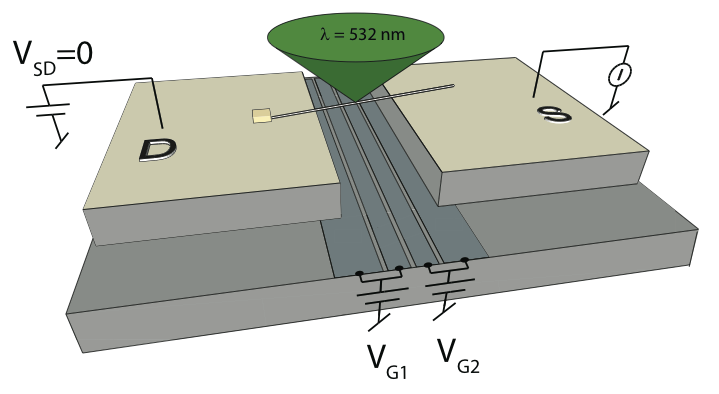In physics, we are used to thinking about the motion of electrons driven by electric fields: electrons are attracted to regions of lower electrostatic potential, like a ball rolling down a hill. When we put a voltage across a resistor, electrons feel a force from the electric field and flow like a river to the place of lowest potential. The effect of electrons flowing “downhill” is also the basis of solar cells, in which they flow in response to the built-in electrostatic voltage in a semiconductor PN junction and generate a current when it is exposed to light.
In their recent work reported in Nature Communications, Gilles Buchs and Salvatore Bagiante, working with Gary Steele in the SteeleLab, have demonstrated that this is not always the case, and in particular, electrons can sometimes be induced to flow “uphill”.
Left: Schematic of the photocurrent imaging experiment with a double-gated suspended carbon nantoube. Right: Observed photocurrent for different doping configurations induced by the gates. In the upper right “pp” region, the sign of the photocurrent indicates that electrons are flowing “uphill” in response to the light
Their work is based on a double-gated semiconducting carbon nanotube, in which the doping level in different parts of the device can be controlled using local gates. Measuring the photo-induced current across the device as the doping levels were changed, Buchs et al. showed that at certain gate voltages, the sign of the current indicated that electrons were flowing “uphill”, against an electric field. This results from the photothemoelectric effect, in which the flow of electrons is driven by differences in chemical potential rather than electrostatic voltage.
The new work solves contradicting reports in the nanotube community about photocurrent generation mechanisms in semiconducting carbon nanotubes, and lays an important framework for interpreting signals in scannning photocurrent microscopy, a technique widely applied to other materials such as graphene, 2D semiconductors, and semiconducting nanowires.
For more information, see the article in Nature Communications, also covered in an article on nanowerk.com. The authors would also like to thank Val Zwiller for experimental support during the project.

